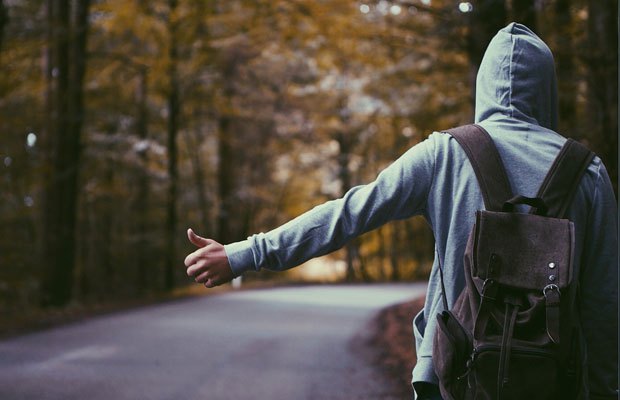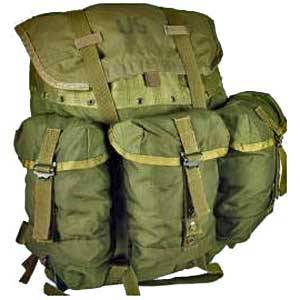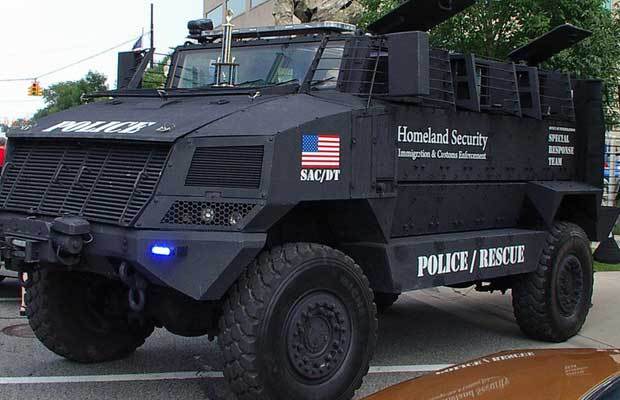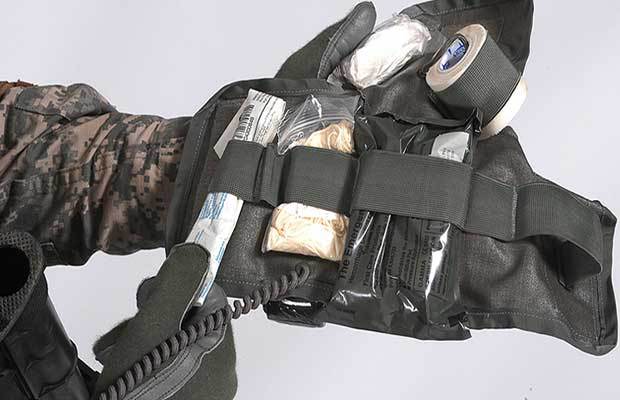Building a Get Home Bag on a Budget, the Thrifty (Aka Cheap) Way
There are a lot of articles out there about building “budget” bug out, GOOD or get home bags, but this one actually provides some alternate sources that anyone can tap into, and builds the complete bag (less EDC items) for under $50.
I was out roaming around the neighborhood, stopping at garage sales a couple of Saturdays ago, and ran across a US Army medium Alice pack with frame for $5. Courtesy of Uncle Sam, I have many miles carrying and quite a few days and nights of experience in the field with Alice packs. While I don’t think they work as well as higher end commercial packs that I use backpacking, they are still decent bags, especially if you keep your load down to 35 pounds or (preferably) less.
The Alice pack was introduced right at the end of the Vietnam War. It is made of heavy nylon, with a divided main compartment, three exterior pockets and a cover flap that has a flat pocket for copies of orders, maps, etc. It also has external attachment points for other Alice gear or for the older style gear with the wire bails that dates back to WWI and for strapping on a sleeping bag at the bottom. It can be carried with or without a frame. With the frame, it has a quick release shoulder strap so you can drop the pack in a hurry in a combat situation or if you get into trouble crossing a stream.
At $5, this was a great buy, the problem was that I already have a couple of them as well as a large Alice pack, and that’s after I gave away two other packs to my son. I am trying to be a bit pickier when it comes to bargains, and was going to pass on this one until I thought it might make a good starting point for an article on putting together a budget Get Home Bag for the Final Prepper picked up two US surplus canteens with carriers at the same sale for $1 each, one of them was a WWII vintage 1943 Stainless canteen. They also came with one canteen cup, stove for the cup, and an unopened bottle of water purification tablets.
The budget get home bag challenge
I decided to sit down and make some “rules” for my challenge.
- Minimize costs, if this gets stolen from my car trunk I don’t want to be out much.
- This bag needed to support three to five days traveling by foot
- It was OK to include footwear, underwear and socks I already own, but I would try to purchase or find whatever else I needed, rather than rely on stuff I already had
- Cost of food would not count against total
- Should be more grey man than tacticool
- Quality stuff
- Cheaper the better, but reliability trumps price
- Minimize on-line purchases
- Bag should support three seasons — spring, summer, fall. May do another article on winter additions
- Need to be able to shoot, move, communicate, eat, water, shelter
Places I would try first to look for bargains are:
- Dumpsters
- Garage sales, estate sales, tag sales
- Thrift stores (goodwill, Salvation Army, DAV, St Vincent De Paul, etc.)
- Bargain stores (Dollar stores, Harbor Freight, etc.) I normally don’t shop at these stores, but have seen some folks talk about prepper bargains they got on Facebook
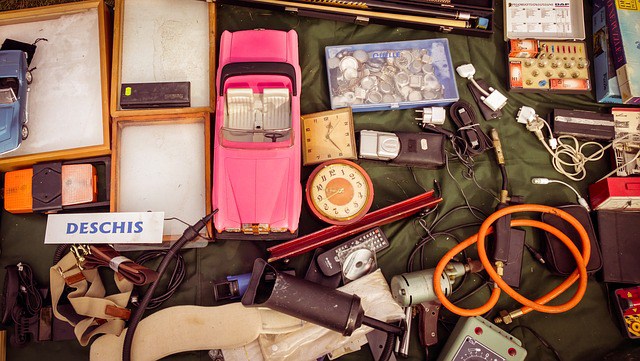
Yard sales are tremendous sources for cheap, gently used gear. You just have to be willing to look.
First, I took stock of my EDC (Every Day Carry) items, so I would know what I had and what I needed to supplement.
My edc includes:
- Key ring with Photon micro lite, p-38 can opener that I got in basic training back in 1976, Swiss Key folding scissors/knife, and Craftsman four in one screwdriver
- Gerber Applegate covert automatic tactical knife (legal in my state, if I am traveling in another state, I switch to a different lock blade non-automatic knife, non-gravity knife)
- Sig P229 DAK in .40 S&W with spare mag. (My carry permits are valid in most states, however if I am driving through somewhere like the socialist republic of Illinois, I unload and store in a locked case in the trunk)
- Swiss Army Knife
- Wallet with emergency cash, ID and credit cards
- Sunglasses
- Bandana
- Laptop and bag including small first aid kit (bandages, tweezers, triple ointment antibiotic, needle, hand cleaner), aspirin, and pseudo-ephedrine, Maglite 2AA cell flashlight (doubles as impact and compliance tool, like a kubotan), cell phone external battery pack (free at a trade show), sewing kit, glasses repair kit with screw driver and spare screws (also free), pens, pencils, notepad, Password protected thumb drives with various files including scans of important personal papers and “survival” manuals
EDC stuff kept in-car that would help with getting home
- Case of water (replaced every three months)
- Box of breakfast bars
- Magnesium flares
- Tool kit
- 50 feet ½ inch rope
- Highway maps
- GPS
Building the get home bag
I gave myself a month to put this kit together and decided to try to keep it under $50 all told, less than some preppers pay for a knife. Here is what I picked up from each source:
Garage sales $20.25
- Alice pack and two canteens $7
- Surefire flashlight (CR123) $1
- Package of four plumbers candles $.25
- Frog Toggs rain gear jacket and pants $2
- 8×10 plastic green/brown tarp $1
- 2 – One liter water bottles (in free stuff box)
- Boy scout compass and signal mirror $1
- Army mountain sleeping bag $5
- Ski poles $3 (make great trekking poles)
Dumpster / Free $0
- Broken sledge-hammer handle (use as self-defense baton)
- Strip maps of route (print out free from Internet)
- Tooth brush/paste (free from dentist)
- Old stained tennis shoes (put them in the bag instead of throwing them away)
- Ball cap from a local business
- Soap (free from hotels)
- Duct Tape (wrapped about 15 feet around one of the water bottles)
- Two pair underpants
- Three pair wool socks
- Two wicking t-shirts
- Hiking boots
- A couple of books of matches (free from store)
Estate / Tag sales $13.50
- Older Plumb hand ax $2 (handle was loose, but easily fixed)
- Folding pruning saw $1
- Pack of 5 new Bic lighters $1
- Hand cranked Eton AM/FM/weather radio with cell phone charger and light $5
- A dozen hand warmers $.50
- First aid kit $2 (various Band-Aids, gauze pads, triangle bandages, burn ointment, antibiotic ointment, tweezers, scissors, scalpel, alcohol wipes, surgical tape)
- Two bath towels $2
Thrift stores (goodwill, Salvation Army, DAV, St Vincent De Paul, etc.) $10.69
- Finnish hunting knife $.50 (it was mixed in with the kitchen knives)
- Zip up fleece shirt/jacket $1
- North face windproof jacket $4
- Columbia hiking pants (Polyester to dry fast) $2
- Watch cap $.50
- REI two person three season tent $2.99 before veteran’s discount, $2.69 final price
Bargain stores $4.50
- Work gloves $1
- Magnesium fire starter $2.50
- Toilet paper $1
So excluding the food, total cost for the Get Home Bag was $47.94. It is well within the abilities of almost anyone to put together a bag like this.
Food $20
- Two pounds rice and two pounds dried beans (stored in one liter water bottles) $5
- Bouillon cubes $1
- Three packs tuna $6
- Two cans Spam $4
- Misc. spices and salt $4
Weapons
Although beyond the scope of this “challenge”, I also checkout out some local pawn shops, a gun show and some Facebook firearms buy sell trade pages to see how cheap I could pick up guns to leave in the car. The best deals I picked up in each category during this time frame were:
- Center-fire rifle – Refinished Spanish Mauser in .308 for $100 (I also picked up a “sporterized” Spanish Mauser in 7mm for $50, but it had no sights, and would have been more that $100 total after adding the sights)
- .22 Rifle – Marlin/Glenfield model 60 spray painted green – $45
- Defensive handgun – S&W 909 with two magazines and holster — $125
- Backup handgun – WWII Nazi marked Mauser HsC in .32 Auto — $35 (it was in rough shape, and I had to straighten the frame, but it shoots great now and is also the ugliest gun I have)
- Stevens 12 ga. pump with barrel cut off crooked at 20 inches and spray painted black stock $75 (I cut the barrel back to 18.5 inches and added a bead)
What bargains have you found for your Get Home Bag and how far were you willing to go to save some money?
There are a lot of articles out there about building “budget” bug out, GOOD or get home bags, but this one actually provides some alternate sources that anyone can tap

